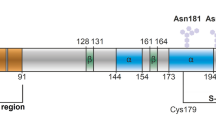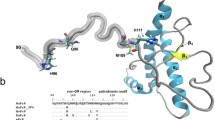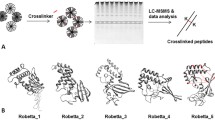Abstract
The GGGTHSQW sequence in the amyloidogenic part of the prion protein is a potential binding site for Cu(II). We have previously studied the binding of copper to the shorter GGGTH peptide and showed that it is highly pH dependent (Hureau et al. in J. Biol. Inorg. Chem. 11:735–744, 2006). Two predominant complexes could be characterized at pH 6.7 and 9.0 with equatorial binding modes of 3N1O and 4N for the metal ion, respectively. In this work, we have further investigated the coordination of Cu(II) to the GGGTH peptide as well as the longer GGGTHSQW peptide in order to identify the oxygen donor ligand at neutral pH and to study the proximity and redox activity of the tryptophan residue of the latter. The results for both peptides show that, at pH 6.7, Cu(II) is coordinated by a carbonyl peptide backbone. At higher pH values, the carbonyl ligand dissociates and the coordination changes to a 4N binding mode, inducing a structural rearrangement that brings the GGGTHSQW peptide’s tryptophan residue into the vicinity of the copper ion, thus affecting their respective redox properties.










Similar content being viewed by others
Abbreviations
- ATR:
-
Attenuated total reflection
- ENDOR:
-
Electron–nuclear double resonance
- EPR:
-
Electron paramagnetic resonance
- ESEEM:
-
Electron spin echo envelope modulation
- FTIR:
-
Fourier transform infrared
- HYSCORE:
-
Hyperfine sublevel correlation
- P5:
-
Ac–GGGTH–NH2
- P8:
-
Ac–GGGTHSQW–NH2
References
Carrell RW, Lomas DA (1997) Lancet 350:134–138
Kelly JW (1998) Curr Opin Struct Biol 8:101–106
Ross CA, Poirier MA (2004) Nat Med 10(Suppl):S10–S17
Sigel A, Sigel H, Sigel RKO (eds) (2006) Neurodegenerative diseases and metal ions. Wiley, Chichester
Millhauser GL (2007) Annu Rev Phys Chem 58:299–320
Aronoff-Spencer E, Burns CS, Avdievich NI, Gerfen GJ, Peisach J, Antholine WE, Ball HL, Cohen FE, Prusiner SB, Millhauser GL (2000) Biochemistry 39:13760–13771
Bonomo RP, Cucinotta V, Giuffrida A, Impellizzeri G, Magri A, Pappalardo G, Rizzarelli E, Santoro AM, Tabbi G, Vagliasindi LI (2005) Dalton Trans 150–158
Burns CS, Aronoff-Spencer E, Dunham CM, Lario P, Avdievich NI, Antholine WE, Olmstead MM, Vrielink A, Gerfen GJ, Peisach J, Scott WG, Millhauser GL (2002) Biochemistry 41:3991–4001
Garnett AP, Viles JH (2003) J Biol Chem 278:6795–6802
Luczkowski M, Kozlowski H, Legowska A, Rolka K, Remelli M (2003) Dalton Trans 619–624
Morante S, Gonzalez-Iglesias R, Potrich C, Meneghini C, Meyer-Klaucke W, Menestrina G, Gasset M (2004) J Biol Chem 279:11753–11759
Pushie MJ, Rauk A (2003) J Biol Inorg Chem 8:53–65
Qin K, Yang Y, Mastrangelo P, Westaway D (2002) J Biol Chem 277:1981–1990
Shiraishi N, Ohta Y, Nishikimi M (2000) Biochem Biophys Res Commun 267:398–402
Stanczak P, Valensin D, Juszczyk P, Grzonka Z, Migliorini C, Molteni E, Valensin G, Gaggelli E, Kozlowski H (2005) Biochemistry 44:12940–12954
Whittal RM, Ball HL, Cohen FE, Burlingame AL, Prusiner SB, Baldwin MA (2000) Protein Sci 9:332–343
Walter ED, Stevens DJ, Visconte MP, Millhauser GL (2007) J Am Chem Soc 129:15440–15441
Brown DR, Guantieri V, Grasso G, Impellizzeri G, Pappalardo G, Rizzarelli E (2004) J Inorg Biochem 98:133–143
Burns CS, Aronoff-Spencer E, Legname G, Prusiner SB, Antholine WE, Gerfen GJ, Peisach J, Millhauser GL (2003) Biochemistry 42:6794–6803
Cereghetti GM, Schweiger A, Glockshuber R, Van Doorslaer S (2001) Biophys J 81:516–525
Gaggelli E, Bernardi F, Molteni E, Pogni R, Valensin D, Valensin G, Remelli M, Luczkowski M, Kozlowski H (2005) J Am Chem Soc 127:996–1006
Hureau C, Charlet L, Dorlet P, Gonnet F, Spadini L, Anxolabéhère-Mallart E, Girerd JJ (2006) J Biol Inorg Chem 11:735–744
Jones CE, Abdelraheim SR, Brown DR, Viles JH (2004) J Biol Chem 279:32018–32027
Van Doorslaer S, Cereghetti GM, Glockshuber R, Schweiger A (2001) J Phys Chem B 105:1631–1639
Shearer J, Soh P (2007) Inorg Chem 46:710–719
Atherton NM, Horsewill AJ (1979) Mol Phys 37:1349–1361
Schosseler PM, Wehrli B, Schweiger A (1997) Inorg Chem 36:4490–4499
Dong J, Canfield JM, Mehta AK, Shokes JE, Tian B, Childers WS, Simmons JA, Mao Z, Scott RA, Warncke K, Lynn DG (2007) Proc Natl Acad Sci USA 104:13313–13318
McCracken J, Pember S, Benkovic SJ, Villafranca JJ, Miller RJ, Peisach J (1988) J Am Chem Soc 110:1069–1074
Harriman A (1987) J Phys Chem 91:6102–6104
DeFelippis MR, Murthy CP, Broitman F, Weinraub D, Faraggi M, Klapper MH (1991) J Phys Chem 95:3416–3419
Bard AJ, Faulkner LR (1980) Electrochemical methods. Fundamentals and applications. Wiley, London
Tommos C, Skalicky JJ, Pilloud DL, Wand AJ, Dutton PL (1999) Biochemistry 38:9495–9507
Posener ML, Adams GE, Wardman P, Cuindall RB (1976) J Chem Soc Faraday Trans I 72:2231–2239
Acknowledgments
This work was supported by a grant from the Agence Nationale de la Recherche, Programme Jeunes Chercheuses Jeunes Chercheurs (ANR-05-JCJC-0010 ‘NEUROARPE’ to P.D., including a postdoctoral fellowship to C.M.). We thank Guillaume Blain for technical assistance and maintenance of the Elexys EPR/ENDOR spectrometer, Emmanuelle Mothes and Luc Guilloreau for fluorescence measurements, Jérôme Santolini for assistance with the ATR-FTIR measurements, Alain Boussac for the use of the pulsed-EPR spectrometer and Elodie Anxolabéhère-Mallart for discussions.
Author information
Authors and Affiliations
Corresponding author
Rights and permissions
About this article
Cite this article
Hureau, C., Mathé, C., Faller, P. et al. Folding of the prion peptide GGGTHSQW around the copper(II) ion: identifying the oxygen donor ligand at neutral pH and probing the proximity of the tryptophan residue to the copper ion. J Biol Inorg Chem 13, 1055–1064 (2008). https://doi.org/10.1007/s00775-008-0389-0
Received:
Accepted:
Published:
Issue Date:
DOI: https://doi.org/10.1007/s00775-008-0389-0




